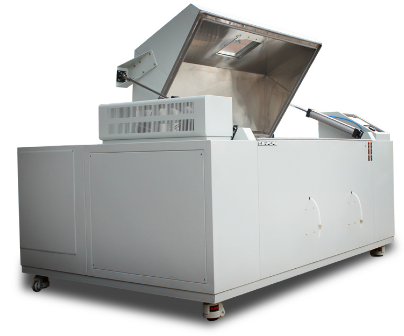The test involves cyclic exposure of the specimens to neutral salt mist, “dry” and “wet” conditions. The type pf test specimens and the exposure period are not specified. The particular advantages of this test over common accelerated tests such as the neutral salt spray (NSS) test lie in its ability to better reproduce the corrosion that occurs in outdoor salt-contaminated environments.
This document is applicable to
--metals and their alloys,
--metallic coatings (anodic and cathodic),
--conversion coatings,
--anodic oxide coatings, and
--organic coatings on metallic materials.
Dissolve a sufficient mass of sodium chloride in distilled or deionized water with a conductivity no higher than 20µS/cm at 25℃±2℃ to produce a concentration of 50 g/l ±5g/l. The sodium chloride concentration of the sprayed solution collected shall be 50g/l±5gl/l. The specific gravity range for a 50g/l±5g/l solution is 1,029 to 1,036 at 25℃.
The sodium chloride shall not contain a mass fraction of the heavy metals of copper, nickel and lead in total more than 0.005%. It shall not contain a mass fraction of sodium iodide more than 0.1% and a mass fraction of total impurities more than 0.5%, calculated for dry salt.
Adjust the PH of the salt solution so that the PH of the sprayed solution collected within the test cabinet is 6.5 to 7.2 at 25℃±2℃. Check the PH using electrometric measurement. Measurements of PH shall be done using electrode suitable for measuring in weakly buffered sodium chloride acid, sodium hydroxide or sodium bicarbonate solution of analytical grade.
All components in contact with the salt mist spray or the test solution shall be made of , or lined with, materials which are resistant to corrosion by the test solution and which do not influence the corrosivity of the sprayed test solution.
The supports for the test specimen shall be constructed such that different substrate types do not influence each other. It shall also be constructed so that the supports themselves do not influence the test specimens.
Test cabinet, that meets the conditions of homogeneity and distribution of the spray. Due to the limited capacity of test cabinets smaller than 0.4m³, the effect of the loading of the test cabinet on the distribution of the spray and temperature shall be carefully considered. The solution shall not be sprayed directly onto the test specimens but rather spread throughout the test cabinet so that it falls naturally down on them. The upper parts of the test cabinet shall be designed so that drops of sprayed solution formed on its surface do not fall on the specimens being tested.

Humidity and temperature control system, that maintains the test cabinet and its contents at the specified temperature and humidity. The temperature shall be measured at a position at least 100mm from walls and radiant heat sources.
Spraying device, for spraying the salt solution during periods of exposure to salt mist spray comprising a supply of air at controlled pressure, a reservoir containing the solution to be sprayed and one or more atomizers.
The compressed air supplied to the atomizers shall be passed through a filter to remove all traces of oil or solid matter and shall be at an overpressure of 70kPa to 170kPa. The pressure is typically 98kPa±10kPa but can vary depending on the type of test cabinet and atomizer used.
Air saturator, consisting of a saturation tower containing hot water at a temperature higher than that of the test cabinet. In order to prevent evaporation of water from the sprayed droplets, the air shall be humidified before entering the atomizer, by passage through this tower.
During periods of exposure to the salt mist, the appropriate temperature depends on the pressure used and on the type of atomizer nozzle and shall be adjusted so that the rate of collection of spray in the test cabinet and the concentration of the collected spray are kept to within the specified limits. The level of water shall be maintained automatically to ensure adequate humidification.
The atomizers shall be made of inert material, e.g. glass or plastic materials. Baffles may be used to prevent direct impact of spray on the test specimens and the use of adjustable baffles is helpful in obtaining constant distribution of spray within the test cabinet. The level of salt solution in the supply tank shall be maintained automatically to ensure constant spray delivery throughout the test.
Collecting devices, at least two, consisting of clean funnels with a collecting area of approximately 80cm² made of glass or other chemically material, with the stems inserted into graduated cylinders or other similar containers. The purpose of the collecting devices is to confirm that the collection rate is within specified limits. They shall be placed in the zone of the test cabinet where the test specimens are placed, one closed to the spray inlet and one remote from an inlet and in such a way that only spray, and not the liquid falling from specimens or from parts of the test cabinet, is collected.
Air dryer, comprising a heating device and fan to supply dried air of the specified humidity during “dry” periods.
Exhaust system, by which air is exhausted from the test cabinet. It shall not be influenced by the back pressure of the atmosphere when the air is released at a point outside the building.
For more details, please feel free to contact sales@lenpure.com
Please visit www.lenpure.com











